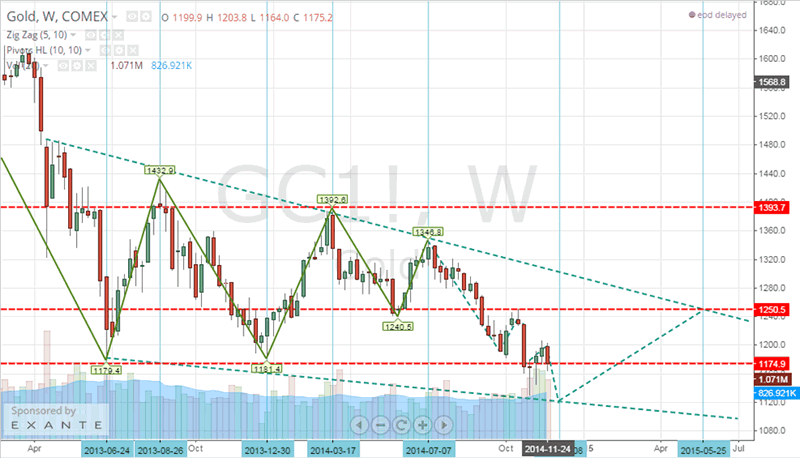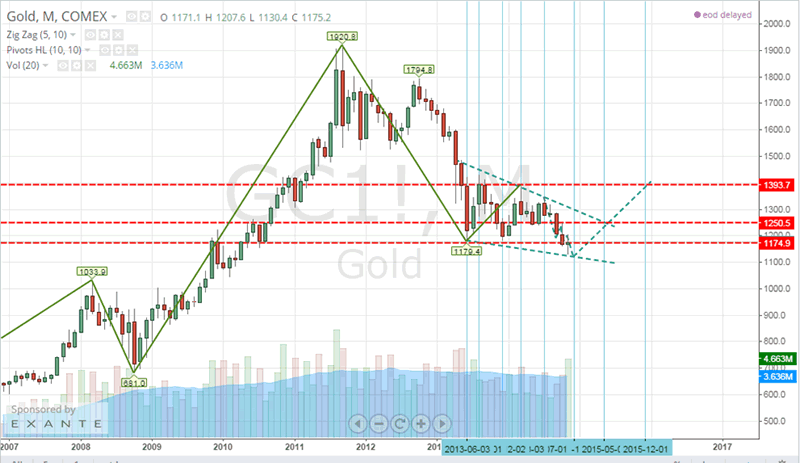With The U.S Market Looking Bullish, How Do You Invest In Gold?
Commodities / Gold and Silver 2014 Dec 04, 2014 - 02:59 PM GMTBy: Submissions
 Nicholas Maithya writes: This year has been one of the best for US equities in recent times, at least judging by the movement of the leading indices – the S&P 500 (SPX), the Dow Jones Industrial Average (DJIA), and the NASDAQ Composite (IXIX), along with their corresponding ETFS. They have all rallied to record highs this year, albeit with dips and rebounds that often characterize an upward trending market.
Nicholas Maithya writes: This year has been one of the best for US equities in recent times, at least judging by the movement of the leading indices – the S&P 500 (SPX), the Dow Jones Industrial Average (DJIA), and the NASDAQ Composite (IXIX), along with their corresponding ETFS. They have all rallied to record highs this year, albeit with dips and rebounds that often characterize an upward trending market.
On the other hand, things remained tough on gold and associated stocks and ETFs, with the precious yellow metal touching new lows last witnessed pre-2011, as the global commodity prices continued to suck in the pressure from a decline in demand.
Now based on recent developments, investors are expecting little to change next year, with the first half of 2015 likely to remain bullish for US equities. With the increase in interest rates looming, there is a great deal of optimism amongst investors with regard to the US equities. Some already have very bullish targets for the leading indices, with the S&P 500 highly tipped to touch 2,200 levels within the first six months.
However, during the second half of the year, things are expected to change significantly with the equities markets possibly facing a notable correction as the effect of increased interest rates begin to hit the economy.
With this in mind, investing in gold and other precious metals provides an interesting scenario for investors.
Gold Weekly Chart

The price of gold could drop further before the end of the year. The current trend indicates that the immediate support level of about $1,174 might not hold to see the year out and hence a drop down towards the $1120-$1150 region.
However, depending on the US economic data expected to come out early next year (economic growth for Q4), there is a chance that the price of gold could bottom at around the $1,150 mark before rebounding back to $1,175 by February.
According to a World Bank report, the price of gold is expected to oscillate between $1,240 and $1,275 per troy ounce for the majority of next year.
For instance, the winter has been a huge factor for dismal economic data over the past, and this is unlikely to change, especially after the US ended QE. Additionally, countries like China, which is one of the world’s leading buyers of gold bullion is expected to boost demand for gold as the country’s economy begins to stabilize after a recent slowdown.
However, with the Swiss having rejected a plan to invest the country’s wealth in gold bullion, there is likelihood that this could cut some of the investor optimism, which could then slowdown the pace of gold price recovery. In fact, the decision by the Swiss could accelerate the drop towards the $1,150 level before the end of the year.
Gold Monthly Chart

Now, looking at the monthly chart, the price of gold appears to have several more targets on the way up than the way down. If the price was to drop anywhere below $1,100, then that could trigger a major meltdown.
However, with the US expected to raise interest rates early next year, this could be what will eventually trigger a major surge in the price of gold. We are looking at a possibility where, if the Federal Reserve stalls the process, then it could send the wrong message about the real status of economic recovery.
On the other hand, if the Fed raises the interest rates and then everything backfires, then that would send butterflies into the stock market, which would trigger a huge demand for gold havens.
The idea of ending QE, however, does not resonate with some analysts who already harbour doubts about the so-called economic recovery. Additionally, with the price of oil hitting new lows last witnessed in 2010, there are fears that the current decline in the price of oil could be signaling the true status of the economy.
Conclusion
The global commodity prices have experienced headwinds largely due to tepid demand. The price of gold, to be specific, has dropped to levels last witnessed in 2010. The yellow metal has in the past, demonstrated its ability to recover after a slowdown and gold bulls will be hoping to see a similar trend in the next few quarters.
Therefore, next year could mark a significant turnaround period for the price of gold, because at the current price levels, the yellow metal presents an interesting opportunity for investors add to their portfolio. After peaking in 2011, the recent decline could be the perfect opportunity for investors to buy gold long-term.
By Nicholas Maithya
Financial analyst by profession with extensive experience in investment reseacrh and stock market analysis. I am currently a published author at Seeking Alpha, and a writer at Quantshare.Com, a trading software company.
© 2014 Copyright Nicholas Maithya - All Rights Reserved
Disclaimer: The above is a matter of opinion provided for general information purposes only and is not intended as investment advice. Information and analysis above are derived from sources and utilising methods believed to be reliable, but we cannot accept responsibility for any losses you may incur as a result of this analysis. Individuals should consult with their personal financial advisors.
© 2005-2022 http://www.MarketOracle.co.uk - The Market Oracle is a FREE Daily Financial Markets Analysis & Forecasting online publication.



